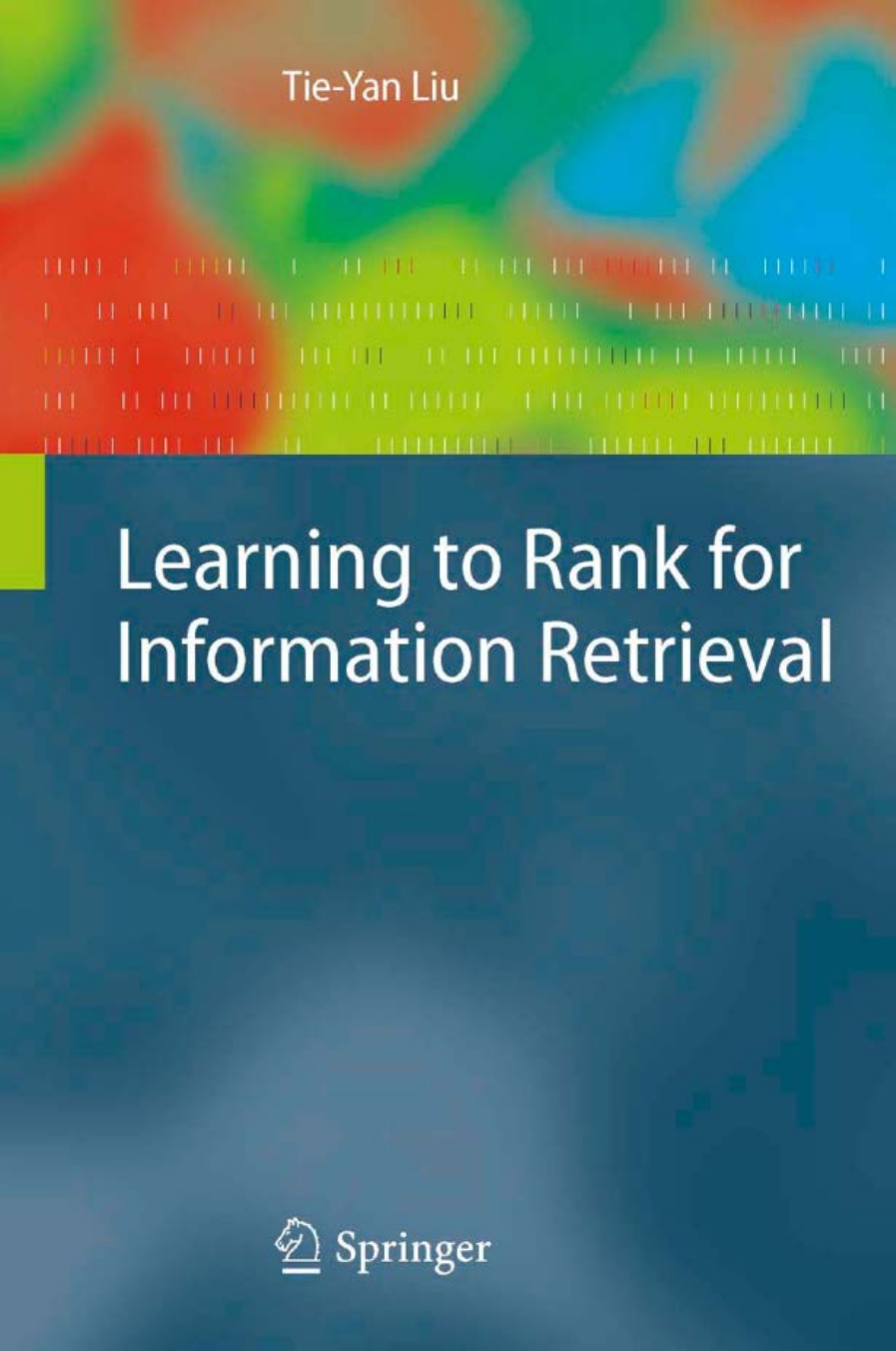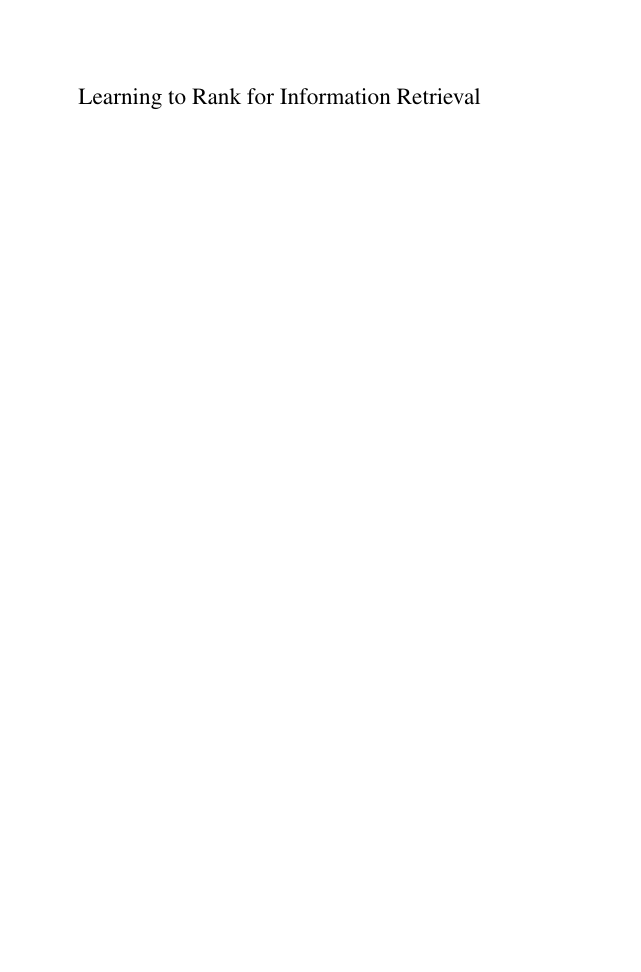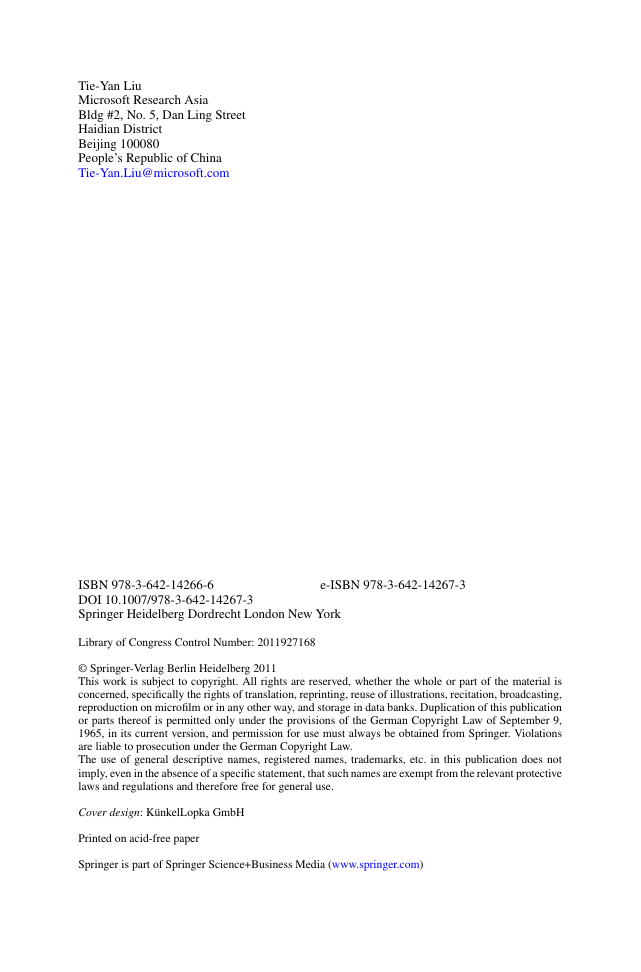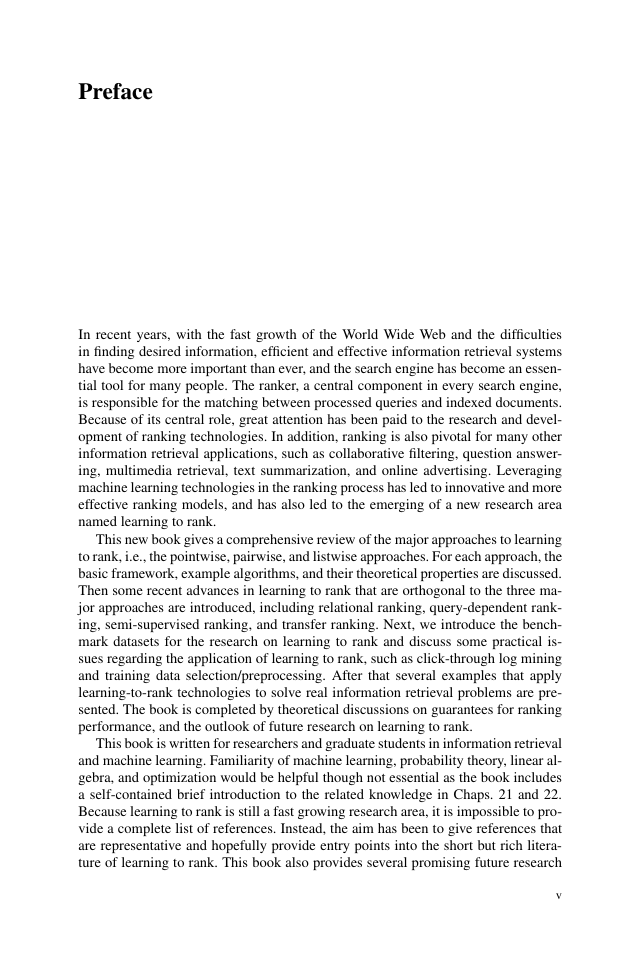Cover
Learning to Rank for Information Retrieval
ISBN 9783642142666
Preface
Acknowledgements
Contents
Part I: Overview of Learning to Rank
Chapter 1: Introduction
1.1 Overview
1.2 Ranking in Information Retrieval
1.2.1 Conventional Ranking Models
1.2.1.1 Relevance Ranking Models
1.2.1.2 Importance Ranking Models
1.2.2 Query-Level Position-Based Evaluations
Mean Reciprocal Rank (MRR)
Mean Average Precision (MAP)
Discounted Cumulative Gain (DCG)
Rank Correlation (RC)
1.3 Learning to Rank
1.3.1 Machine Learning Framework
1.3.2 Definition of Learning to Rank
Feature Based
Discriminative Training
1.3.3 Learning-to-Rank Framework
1.3.3.1 The Pointwise Approach
1.3.3.2 The Pairwise Approach
1.3.3.3 The Listwise Approach
1.4 Book Overview
1.5 Exercises
References
Part II: Major Approaches to Learning to Rank
Chapter 2: The Pointwise Approach
2.1 Overview
2.2 Regression-Based Algorithms
2.2.1 Subset Ranking with Regression
2.3 Classification-Based Algorithms
2.3.1 Binary Classification for Ranking
SVM-Based Method
Logistic Regression-Based Method
2.3.2 Multi-class Classification for Ranking
Boosting Tree-Based Method
Association Rule Mining-Based Method
2.4 Ordinal Regression-Based Algorithms
2.4.1 Perceptron-Based Ranking (PRanking)
2.4.2 Ranking with Large Margin Principles
2.4.3 Ordinal Regression with Threshold-Based Loss Functions
2.5 Discussions
2.5.1 Relationship with Relevance Feedback
2.5.2 Problems with the Pointwise Approach
2.5.3 Improved Algorithms
2.6 Summary
2.7 Exercises
References
Chapter 3: The Pairwise Approach
3.1 Overview
3.2 Example Algorithms
3.2.1 Ordering with Preference Function
3.2.2 SortNet: Neural Network-Based Sorting Algorithm
3.2.3 RankNet: Learning to Rank with Gradient Descent
3.2.4 FRank: Ranking with a Fidelity Loss
3.2.5 RankBoost
3.2.6 Ranking SVM
3.2.7 GBRank
3.3 Improved Algorithms
3.3.1 Multiple Hyperplane Ranker
3.3.2 Magnitude-Preserving Ranking
3.3.3 IR-SVM
3.3.4 Robust Pairwise Ranking with Sigmoid Functions
3.3.5 P-norm Push
3.3.6 Ordered Weighted Average for Ranking
3.3.7 LambdaRank
3.3.8 Robust Sparse Ranker
3.4 Summary
3.5 Exercises
References
Chapter 4: The Listwise Approach
4.1 Overview
4.2 Minimization of Measure-Specific Loss
4.2.1 Measure Approximation
4.2.1.1 SoftRank
4.2.1.2 Decision Theoretic Framework for Ranking
4.2.1.3 Approximate Rank
4.2.1.4 SmoothRank
4.2.2 Bound Optimization
4.2.2.1 SVMmap
4.2.3 Non-smooth Optimization
4.2.3.1 AdaRank
4.2.3.2 Genetic Programming Based Algorithms
4.2.4 Discussions
4.3 Minimization of Non-measure-Specific Loss
4.3.1 ListNet
4.3.2 ListMLE
4.3.3 Ranking Using Cumulative Distribution Networks
4.3.4 BoltzRank
4.4 Summary
4.5 Exercises
References
Chapter 5: Analysis of the Approaches
5.1 Overview
5.2 The Pointwise Approach
5.3 The Pairwise Approach
5.4 The Listwise Approach
5.4.1 Non-measure-Specific Loss
5.4.2 Measure-Specific Loss
5.5 Summary
5.6 Exercises
References
Part III: Advanced Topics in Learning to Rank
Chapter 6: Relational Ranking
6.1 General Relational Ranking Framework
6.1.1 Relational Ranking SVM
6.1.2 Continuous Conditional Random Fields
6.2 Learning Diverse Ranking
6.3 Discussions
References
Chapter 7: Query-Dependent Ranking
7.1 Query-Dependent Loss Function
7.2 Query-Dependent Ranking Function
7.2.1 Query Classification-Based Approach
7.2.2 K Nearest Neighbor-Based Approach
7.2.3 Query Clustering-Based Approach
7.2.4 Two-Layer Learning Approach
7.3 Discussions
References
Chapter 8: Semi-supervised Ranking
8.1 Inductive Approach
8.2 Transductive Approach
8.3 Discussions
References
Chapter 9: Transfer Ranking
9.1 Feature-Level Transfer Ranking
9.2 Instance-Level Transfer Ranking
9.3 Discussions
References
Part IV: Benchmark Datasets for Learning to Rank
Chapter 10: The LETOR Datasets
10.1 Overview
10.2 Document Corpora
10.2.1 The "Gov" Corpus and Six Query Sets
10.2.2 The OHSUMED Corpus
10.2.3 The "Gov2" Corpus and Two Query Sets
10.3 Document Sampling
10.4 Feature Extraction
10.5 Meta Information
10.6 Learning Tasks
10.7 Discussions
References
Chapter 11: Experimental Results on LETOR
11.1 Experimental Settings
11.2 Experimental Results on LETOR 3.0
11.3 Experimental Results on LETOR 4.0
11.4 Discussions
11.5 Exercises
References
Chapter 12: Other Datasets
12.1 Yahoo! Learning-to-Rank Challenge Datasets
12.2 Microsoft Learning-to-Rank Datasets
12.3 Discussions
References
Part V: Practical Issues in Learning to Rank
Chapter 13: Data Preprocessing for Learning to Rank
13.1 Overview
13.2 Ground Truth Mining from Logs
13.2.1 User Click Models
13.2.1.1 Dependent Click Model
13.2.1.2 Bayesian Browsing Model
13.2.1.3 Dynamic Bayesian Network Click Model
13.2.2 Click Data Enhancement
13.2.2.1 Learning a User Interaction Model
13.2.2.2 Smoothing Click-Through Data
13.3 Training Data Selection
13.3.1 Document and Query Selection for Labeling
13.3.1.1 Deep Versus Shallow Judgments
13.3.1.2 Actively Learning for Labeling
13.3.2 Document and Query Selection for Training
13.3.2.1 Document Selection Strategies
13.3.2.2 Data Selection by Optimizing PPC
13.3.3 Feature Selection for Training
13.4 Summary
13.5 Exercises
References
Chapter 14: Applications of Learning to Rank
14.1 Overview
14.2 Question Answering
14.2.1 Definitional QA
14.2.2 Quantity Consensus QA
14.2.3 Non-factoid QA
14.2.4 Why QA
14.3 Multimedia Retrieval
14.4 Text Summarization
14.5 Online Advertising
14.6 Summary
14.7 Exercises
References
Part VI: Theories in Learning to Rank
Chapter 15: Statistical Learning Theory for Ranking
15.1 Overview
15.2 Statistical Learning Theory
15.3 Learning Theory for Ranking
15.3.1 Statistical Ranking Framework
15.3.2 Generalization Analysis for Ranking
15.3.3 Statistical Consistency for Ranking
15.4 Exercises
References
Chapter 16: Statistical Ranking Framework
16.1 Document Ranking Framework
16.1.1 The Pointwise Approach
16.1.2 The Pairwise Approach
(1) The U-statistics View
(2) The Average View
16.1.3 The Listwise Approach
16.2 Subset Ranking Framework
16.2.1 The Pointwise Approach
16.2.2 The Pairwise Approach
16.2.3 The Listwise Approach
16.3 Two-Layer Ranking Framework
16.3.1 The Pointwise Approach
16.3.2 The Pairwise Approach
(1) The U-statistics View
(2) The Average View
16.3.3 The Listwise Approach
16.4 Summary
16.5 Exercises
References
Chapter 17: Generalization Analysis for Ranking
17.1 Overview
17.2 Uniform Generalization Bounds for Ranking
17.2.1 For Document Ranking
17.2.2 For Subset Ranking
17.2.3 For Two-Layer Ranking
17.3 Algorithm-Dependent Generalization Bound
17.3.1 For Document Ranking
17.3.2 For Subset Ranking
17.3.3 For Two-Layer Ranking
17.4 Summary
17.5 Exercises
References
Chapter 18: Statistical Consistency for Ranking
18.1 Overview
18.2 Consistency Analysis for Document Ranking
18.2.1 Regarding Pairwise 0-1 Loss
18.3 Consistency Analysis for Subset Ranking
18.3.1 Regarding DCG-Based Ranking Error
18.3.2 Regarding Permutation-Level 0-1 Loss
18.3.3 Regarding Top-k True Loss
18.3.4 Regarding Weighted Kendall's tau
18.4 Consistency Analysis for Two-Layer Ranking
18.5 Summary
18.6 Exercises
References
Part VII: Summary and Outlook
Chapter 19: Summary
References
Chapter 20: Future Work
20.1 Sample Selection Bias
20.2 Direct Learning from Logs
20.3 Feature Engineering
20.4 Advanced Ranking Models
20.5 Large-Scale Learning to Rank
20.6 Online Complexity Versus Accuracy
20.7 Robust Learning to Rank
20.8 Online Learning to Rank
20.9 Beyond Ranking
References
Part VIII: Appendix
Chapter 21: Mathematical Background
21.1 Probability Theory
21.1.1 Probability Space and Random Variables
21.1.2 Probability Distributions
21.1.2.1 Discrete Distribution
21.1.2.2 Continuous Distribution
21.1.2.3 Popular Distributions
21.1.3 Expectations and Variances
21.2 Linear Algebra and Matrix Computation
21.2.1 Notations
21.2.2 Basic Matrix Operations and Properties
21.2.2.1 Matrix Multiplication
21.2.2.2 Identity Matrix
21.2.2.3 Diagonal Matrix
21.2.2.4 Transpose
21.2.2.5 Symmetric Matrix
21.2.2.6 Trace
21.2.2.7 Norm
21.2.2.8 Inverse
21.2.2.9 Orthogonal Matrix
21.2.2.10 Determinant
21.2.2.11 Quadratic Form
21.2.3 Eigenvalues and Eigenvectors
21.3 Convex Optimization
21.3.1 Convex Set and Convex Function
21.3.2 Conditions for Convexity
21.3.2.1 First-Order Condition
21.3.2.2 Second-Order Condition
21.3.3 Convex Optimization Problem
21.3.4 Lagrangian Duality
21.3.5 KKT Conditions
References
Chapter 22: Machine Learning
22.1 Regression
22.1.1 Linear Regression
22.1.2 Probabilistic Explanation
22.2 Classification
22.2.1 Neural Networks
22.2.2 Support Vector Machines
22.2.3 Boosting
22.2.4 K Nearest Neighbor (KNN)
22.3 Statistical Learning Theory
22.3.1 Formalization
22.3.2 Bounds for |R(g) - R(g)|
22.3.2.1 Hoeffding's Inequality
22.3.2.2 Uniform Bounds in Finite Case
22.3.2.3 Uniform Bounds in Infinite Case
22.3.2.4 Uniform Bounds Based on Covering Number
22.3.2.5 Uniform Bounds Based on Rademacher Average
References
Index
















 2023年江西萍乡中考道德与法治真题及答案.doc
2023年江西萍乡中考道德与法治真题及答案.doc 2012年重庆南川中考生物真题及答案.doc
2012年重庆南川中考生物真题及答案.doc 2013年江西师范大学地理学综合及文艺理论基础考研真题.doc
2013年江西师范大学地理学综合及文艺理论基础考研真题.doc 2020年四川甘孜小升初语文真题及答案I卷.doc
2020年四川甘孜小升初语文真题及答案I卷.doc 2020年注册岩土工程师专业基础考试真题及答案.doc
2020年注册岩土工程师专业基础考试真题及答案.doc 2023-2024学年福建省厦门市九年级上学期数学月考试题及答案.doc
2023-2024学年福建省厦门市九年级上学期数学月考试题及答案.doc 2021-2022学年辽宁省沈阳市大东区九年级上学期语文期末试题及答案.doc
2021-2022学年辽宁省沈阳市大东区九年级上学期语文期末试题及答案.doc 2022-2023学年北京东城区初三第一学期物理期末试卷及答案.doc
2022-2023学年北京东城区初三第一学期物理期末试卷及答案.doc 2018上半年江西教师资格初中地理学科知识与教学能力真题及答案.doc
2018上半年江西教师资格初中地理学科知识与教学能力真题及答案.doc 2012年河北国家公务员申论考试真题及答案-省级.doc
2012年河北国家公务员申论考试真题及答案-省级.doc 2020-2021学年江苏省扬州市江都区邵樊片九年级上学期数学第一次质量检测试题及答案.doc
2020-2021学年江苏省扬州市江都区邵樊片九年级上学期数学第一次质量检测试题及答案.doc 2022下半年黑龙江教师资格证中学综合素质真题及答案.doc
2022下半年黑龙江教师资格证中学综合素质真题及答案.doc